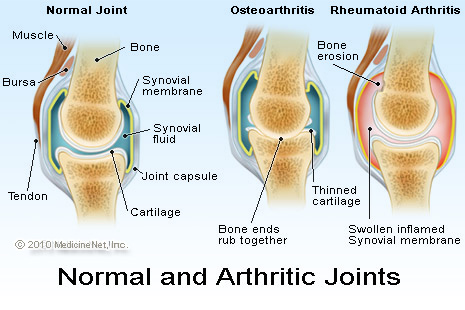Arthritis is defined as a condition in which there is an ongoing chronic process of inflammation in the joints that makes it harder to maintain normal motility functions. This inflammation appears when the normal fluid present in between the joints begins to decrease and then eventually disappears. As a result the joint loses its shock absorbing property. According to American Academy of Orthopedic Surgeons approximately 1 of every 5 Americana are suffering from the arthritis of one or more joints of the body.

How Do You Know If You Have Arthritis?
If you are wondering "Do I have arthritis", you may need the following signs. Here are 8 common symptoms that will help you solve the question of "how do you know if you have arthritis":
1. Pain in Joints
"How do I know if I have arthiritis?" The first sign is joint pain.
- Pain in joints is one of the most common symptoms found in the arthritis patients.
- This pain can vary according to severity and progression of arthritis. In most patients, a sharp and deep aching pain is reported which gets worsen with physical activity or with extra pressure.
2. Swelling
- Swelling is a general symptom which is seen in several medical conditions.
- Swelling specifically in joints appears in the setting of arthritis. But a differential diagnosis can be made as swelling in joints can be a result of moderate to severe joint injury.
- The examination of fluid present in the joint cavity can also confirm the diagnosis of arthritis.
3. Stiffness in Joints
- It has been observed that joint movements are usually compromised in the arthritis patients.A comparison can be made by evaluating the quality and strength of joint motion between diseased and non-diseased joints.
- Many patients reported that the stiffness of joints gets worse at the dawn time or when too much activity is performed with the affected joint.
- Application of warm compresses and use of anti-inflammatory medications such as ibuprofen is also found effective in reducing the pain and stiffness.
4. Joint Deformity
- The perfect anatomical appearance and alignment of joints is maintained via the complex interplay of cartilage and fluids present in between the joints. The cartilage and fluids progressively degenerate due to wear and tear changes within the joint matrix body, thereby leading to joint deformities.
- Most cases of longstanding or poorly managed arthritis presents with crooked fingers and bowed legs.
5. Grinding Sensations
- As progressive degeneration of cartilage continues, the wearing off of protective barrier further deteriorates. As a result, a grinding sensation is felt due to one joint rubbing over another.
- Grinding sensation can be checked by placing one hand over the joint and moving it in back and forth direction.
6. Lumps and Bumps
- Mucous cysts (accumulation of fluid) and bone spurs are formed after arthritis. These pockets of fluids appear as bumps and lumps around the joint. Generally these bumps do not cause any pain and are insensitive to touch.
- Most common site for these knobby protuberances includes fingers of both hand and feet.
7. Tenderness in Joints
Joint tenderness on touch is a common symptom of arthritis. Arm joint is usually involved with severe pain of joint tenderness.Inflammation is present along with aching sensations which are felt when the joint is pressed.
8. Warm Joints
- The inflammation makes the joint red and warm to touch.
- Joint redness can also be a symptom of a joint infection; a physician will evaluate the condition after examination.
Know the Specific Early Signs of 4 Kinds of Arthritis
1. Early signs of Osteoarthritis
- Larger joints such as hip and knees are affected due to osteoarthritis. Small joints such as toes and neck may also get affected.
- Joint stiffness is common in osteoarthritis.
- Sore joints are observed even when not moved for a longer period of time.
2. Early signs of Rheumatoid Arthritis
- Pain and swelling are the common symptoms of rheumatoid arthritis
- Large joints such as knees and small joints such as fingers are commonly affected.
- It is characterized under symmetrical disease which means that if one finger is swelled, the same fingers of the other hand will also get swelled up.
- Fever with shortness of breath is some symptoms which are observed in rheumatoid arthritis but are not related to joint.
3. Early signs of Psoriatic Arthritis
- It is characterized as an autoimmune disease, which means that the body will start producing the immune cells against its own cells.
- Inflammation, swelling with severe pain in joints is present.
- Changes in nail structure and redness in eyes are also commonly observed.
4. Early signs of Gout
- Large joints such as knee and big toe are commonly affected in gout.
- Tingling sensations in joint with alternate episodes of pain (that come and go) are present.
- After progression, swelling and pain may develop.
When to Seek Medical Help
Consultation with the physician become necessary if any of the following condition is observed.
- Sudden onset of stiffness and pain from unknown cause
- Swelling with high grade fever
- Joint tenderness which in not eliminated even after application of warm compress.
- Joint stiffness at night time
Treatment for Arthritis
Treatment plan is suggested after evaluating severity of disease and patient conditions for instance age, gender etc.The goal of treating arthritis is to manage the pain to regain a patient's mobility. Treatment of arthritis can be done through:
- Medications such as anti-inflammatory, analgesics, etc.
- Application of heat and cold compress
- Physiotherapy and exercises
- Surgery